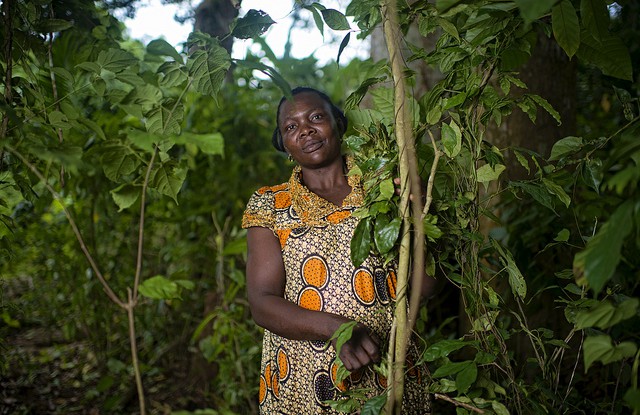Until a few decades ago, the climbing vine Gnetum spp. – called Okok or Eru in different parts of Cameroon — remained an obscure delicacy. Prized by domestic traders and consumers in Cameroon and the Democratic Republic of Congo, it has been eaten raw for hundreds of years to combat all manner of illnesses or finely shredded and added to soups and stews.
Indeed, until a few decades ago, such lucrative perennial crops as cocoa dominated export markets. But as demand for cocoa stagnated and consumer countries stockpiled cocoa beans to regulate the market to their advantage, the price per kilogram plummeted from $3 in 1986, to $1.50 in 1988.
Cameroon’s male farmers – many of whom rely on the seasonal cultivation of cocoa for their incomes – have since turned to the women of the household to assist by harvesting non-timber forest products like okok that are available all year round.
Okok has become not only one of Cameroon’s most widely consumed vegetables, but it also accounts for a significant proportion of the international trade of non timber forest products (NTFPs). Hundreds of tons of okok are exported every week to Nigeria, as well as to Europe and America where it is consumed by Central and West Africans living abroad.
Contrary to common belief, the success of Okok’s commercialization is not only linked to the fall in the prices of cocoa – though it is one of the key factors for its success – but rather because of its high commercial value. CIFOR research has shown that the Okok trade in Cameroon is estimated to top $12 million a year and is the third most valuable NTFP in the country, behind only fish and fuelwood.
During the three months of the year when cocoa is not being harvested, the income women earn each day from okok sales is providing a significant economic opportunity to bring families out of rural poverty.
Women are involved in all stages of the process – harvesting, transportation and sales. Says Calixte Mbilong from the village of Minwoho, Cameroon: “When I make 35,000 Francs CFA ($70) a week, it is important for me. It is with this money that we pay our children’s school fees, take care of our health, and buy clothing. It allows me to buy all that I need.”
A recent survey we conducted in the Lekie division of Cameroon showed that up to 90 percent of people selling okok are females and, in 75 percent of the households interviewed, men recognized that women control okok collection. But in spite of the significant contribution okok makes to the household income, we found that men tended to devote most of their time to other household activities such as cocoa and hunting because they were not convinced that okok could provide sufficient return for the labor they undertook, instead believing it is an activity best conducted by women and children.
While the increased awareness of local communities of okok’s economic value has seen production and incomes in local Cameroonian communities increase, discriminatory constraints are making it difficult for farmers and traders to continue to reap benefits from the leafy green.
In 2006, okok was labelled as a “special forestry product” in Cameroon — allowing an inter-ministerial committee led by the Ministry of Forestry and Wildlife to allocate trading quotas. It’s now become illegal to trade okok without a quota and unfortunately, most of the quotas have been allocated to a few companies or individuals who are often not involved in the value chain development of okok. For traders and rural communities to officially participate in okok export, they have to purchase part of the quota of others (called a way bill or lettre de voiture) and are often paying prices way above the normal quota cost.
Until now, the majority of companies receiving quotas are controlled by men, which discriminates against the main users of okok — women. This trading quota has a negative impact on women as it significantly reduces their income due to the cost of way bills.
In 2007, we recommended that quota allocations be made more transparent through a system of bidding. The system should be decentralised so that it can give a chance to women’s groups who control okok collection and trade.
This will allow more competition among market participants and will increase the amount of tax revenues for the government. Many women’s groups have indicated that they would be more happy to pay official taxes rather than the money they currently pay to the owners of quotas.
It’s important that policymakers take appropriate actions to support the importance of okok incomes to women and to households in Cameroon – and adopting these quota reforms is just one way. As it climbs out of obscurity and onto the plates of diners across the world, the leafy green okok will surely only become more prized.
For more information on the issues discussed in this article, please contact Abdon Awono at a.abdon@cgiar.org
CIFOR’s research on non-timber forest products in the Congo basin form part of the CGIAR Research Program on Forests, Trees and Agroforestry.
We want you to share Forests News content, which is licensed under Creative Commons Attribution-NonCommercial-ShareAlike 4.0 International (CC BY-NC-SA 4.0). This means you are free to redistribute our material for non-commercial purposes. All we ask is that you give Forests News appropriate credit and link to the original Forests News content, indicate if changes were made, and distribute your contributions under the same Creative Commons license. You must notify Forests News if you repost, reprint or reuse our materials by contacting forestsnews@cifor-icraf.org.
